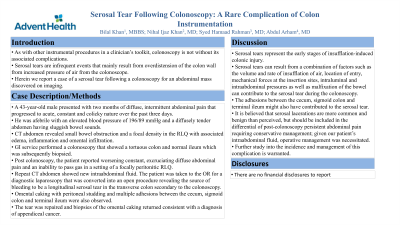Sunday Poster Session
Category: Colon
P0264 - Serosal Tear Following Colonoscopy: A Rare Complication of Colon Instrumentation
Sunday, October 22, 2023
3:30 PM - 7:00 PM PT
Location: Exhibit Hall

Has Audio

Bilal Khan, MBBS
Allama Iqbal Medical College
Orlando, FL
Presenting Author(s)
Bilal Khan, MBBS1, Nihal Ijaz Khan, MD2, Syed Hamaad Rahman, DO3, Abdul Arham, MBBS, MD4
1Allama Iqbal Medical College, Orlando, FL; 2AdventHealth, Orlando, FL; 3Methodist Dallas Medical Center, Dallas, TX; 4UMass Chan-Baystate Medical Center, Springfield, MA
Introduction: As with other instrumental procedures in a clinician’s toolkit, colonoscopy is not without its associated complications. Serosal tears are infrequent events that mainly result from overdistension of the colon wall from increased pressure of air from the colonoscope. Herein we report a case of a serosal tear following a colonoscopy for an abdominal mass discovered on imaging.
Case Description/Methods: A 43-year-old male presented with two months of diffuse, intermittent abdominal pain that progressed to acute, constant and colicky nature over the past three days. He was afebrile with an elevated blood pressure of 196/89 mmHg and a diffusely tender abdomen having sluggish bowel sounds. CT abdomen revealed small bowel obstruction and a focal density in the RLQ with associated edema, inflammation and omental infiltration. GI service performed a colonoscopy that showed a tortuous colon and normal ileum which was subsequently biopsied. Post colonoscopy, the patient reported worsening constant, excruciating diffuse abdominal pain and an inability to pass gas in a setting of a focally peritonitic RLQ. Repeat CT abdomen showed new intraabdominal fluid. The patient was taken to the OR for a diagnostic laparoscopy that was converted into an open procedure revealing the source of bleeding to be a longitudinal serosal tear in the transverse colon secondary to the colonoscopy. Omental caking with peritoneal studding and multiple adhesions between the cecum, sigmoid colon and terminal ileum were also observed. The tear was repaired and biopsies of the omental caking returned consistent with a diagnosis of appendiceal cancer.
Discussion: Serosal tears represent the early stages of insufflation-induced colonic injury. Serosal tears can result from a combination of factors such as the volume and rate of insufflation of air, location of entry, mechanical forces at the insertion sites, intraluminal and intraabdominal pressures as well as malfixation of the bowel can contribute to the serosal tear during the colonoscopy. The adhesions between the cecum, sigmoid colon and terminal ileum might also have contributed to the serosal tear. It is believed that serosal lacerations are more common and benign than perceived, but should be included in the differential of post-colonoscopy persistent abdominal pain requiring conservative management; given our patient’s intraabdominal fluid, operative management was necessitated. Further study into the incidence and management of this complication is warranted.
Disclosures:
Bilal Khan, MBBS1, Nihal Ijaz Khan, MD2, Syed Hamaad Rahman, DO3, Abdul Arham, MBBS, MD4. P0264 - Serosal Tear Following Colonoscopy: A Rare Complication of Colon Instrumentation, ACG 2023 Annual Scientific Meeting Abstracts. Vancouver, BC, Canada: American College of Gastroenterology.
1Allama Iqbal Medical College, Orlando, FL; 2AdventHealth, Orlando, FL; 3Methodist Dallas Medical Center, Dallas, TX; 4UMass Chan-Baystate Medical Center, Springfield, MA
Introduction: As with other instrumental procedures in a clinician’s toolkit, colonoscopy is not without its associated complications. Serosal tears are infrequent events that mainly result from overdistension of the colon wall from increased pressure of air from the colonoscope. Herein we report a case of a serosal tear following a colonoscopy for an abdominal mass discovered on imaging.
Case Description/Methods: A 43-year-old male presented with two months of diffuse, intermittent abdominal pain that progressed to acute, constant and colicky nature over the past three days. He was afebrile with an elevated blood pressure of 196/89 mmHg and a diffusely tender abdomen having sluggish bowel sounds. CT abdomen revealed small bowel obstruction and a focal density in the RLQ with associated edema, inflammation and omental infiltration. GI service performed a colonoscopy that showed a tortuous colon and normal ileum which was subsequently biopsied. Post colonoscopy, the patient reported worsening constant, excruciating diffuse abdominal pain and an inability to pass gas in a setting of a focally peritonitic RLQ. Repeat CT abdomen showed new intraabdominal fluid. The patient was taken to the OR for a diagnostic laparoscopy that was converted into an open procedure revealing the source of bleeding to be a longitudinal serosal tear in the transverse colon secondary to the colonoscopy. Omental caking with peritoneal studding and multiple adhesions between the cecum, sigmoid colon and terminal ileum were also observed. The tear was repaired and biopsies of the omental caking returned consistent with a diagnosis of appendiceal cancer.
Discussion: Serosal tears represent the early stages of insufflation-induced colonic injury. Serosal tears can result from a combination of factors such as the volume and rate of insufflation of air, location of entry, mechanical forces at the insertion sites, intraluminal and intraabdominal pressures as well as malfixation of the bowel can contribute to the serosal tear during the colonoscopy. The adhesions between the cecum, sigmoid colon and terminal ileum might also have contributed to the serosal tear. It is believed that serosal lacerations are more common and benign than perceived, but should be included in the differential of post-colonoscopy persistent abdominal pain requiring conservative management; given our patient’s intraabdominal fluid, operative management was necessitated. Further study into the incidence and management of this complication is warranted.
Disclosures:
Bilal Khan indicated no relevant financial relationships.
Nihal Ijaz Khan indicated no relevant financial relationships.
Syed Hamaad Rahman indicated no relevant financial relationships.
Abdul Arham indicated no relevant financial relationships.
Bilal Khan, MBBS1, Nihal Ijaz Khan, MD2, Syed Hamaad Rahman, DO3, Abdul Arham, MBBS, MD4. P0264 - Serosal Tear Following Colonoscopy: A Rare Complication of Colon Instrumentation, ACG 2023 Annual Scientific Meeting Abstracts. Vancouver, BC, Canada: American College of Gastroenterology.
